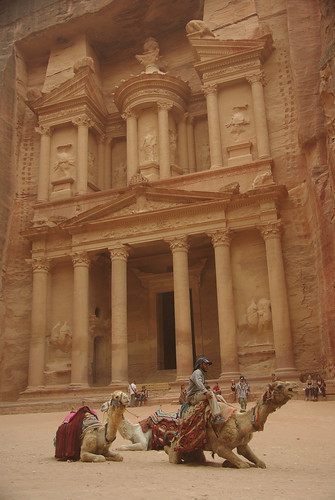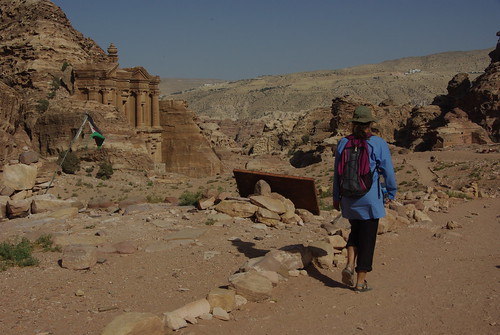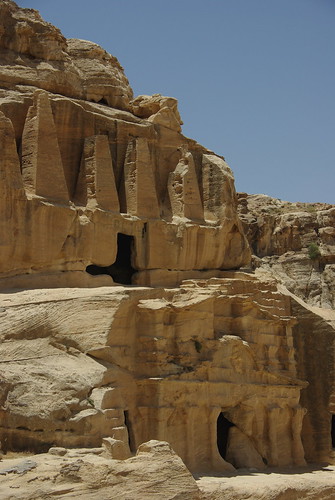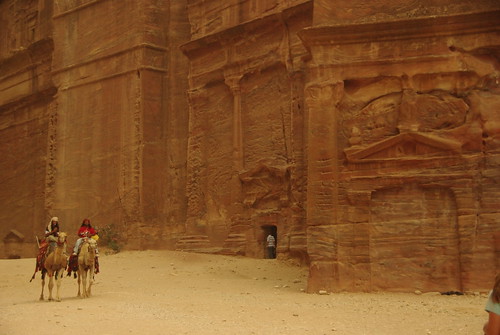 Although we had been tipped off not to arrive until the afternoon when the tour groups depart, we were shocked at the sheer number of visitors. With no exaggeration there were thousands of people exploring Petra when we arrived mid-day, and the noise bouncing off the canyon walls in front of the treasury sounded more like a stock market trading floor than an ancient archaeological site. After being abandoned by the free tour guide, who began by telling us the tour was not obligatory and we could leave at anytime, we headed off straight to the Monastery, a 40 minute hike at the far end of the site. By no means a secret place, the Monastery was virtually deserted late in the afternoon and for long stretches of time we had the place nearly to ourselves. It was magnificent and the views from the surrounding cliffs were breathtaking.
Although we had been tipped off not to arrive until the afternoon when the tour groups depart, we were shocked at the sheer number of visitors. With no exaggeration there were thousands of people exploring Petra when we arrived mid-day, and the noise bouncing off the canyon walls in front of the treasury sounded more like a stock market trading floor than an ancient archaeological site. After being abandoned by the free tour guide, who began by telling us the tour was not obligatory and we could leave at anytime, we headed off straight to the Monastery, a 40 minute hike at the far end of the site. By no means a secret place, the Monastery was virtually deserted late in the afternoon and for long stretches of time we had the place nearly to ourselves. It was magnificent and the views from the surrounding cliffs were breathtaking.
An important commercial hub of the ancient world, the building of Petra was influenced by nearly every civilization along the Mediterranean, so wandering through what remains of the city is like a walk through history. Tombs built in Hellenistic, Egyptian and Mesopotamian style dominate the route through Petra, but there’s also an amazing Byzantine mosaic in the Church and some pretty interesting Assyrian architecture. Hundreds of tombs remain carved into the sandstone, each doorway leading to a chiseled out burial chamber or banquet room. Over time new trade routes were discovered cutting Petra out of the caravan route and ultimately much of history as well. It wasn’t until its rediscovery in 1812 that it became re-known to someone other than a Bedouin…
ultimately much of history as well. It wasn’t until its rediscovery in 1812 that it became re-known to someone other than a Bedouin…
Although nothing remains inside the tombs today, local Bedouins lived in many of the caves until the 1980s. Thrown out of the site by the government and moved into modern apartment complexes outside the site, tension remains between the Bedouins and the Jordanian government. To appease the Bedouins, the government has looked the other way at the numerous souvenir shops, food stalls and wandering vendors scattered throughout Petra. Without a doubt the market like atmosphere near the amphitheater takes away from the grandeur of the place. Unfortunately we saw children selling jewelry and goods throughout the site in numbers that we haven’t seen since Central America.
 The most photographed site in Petra is the Treasury, which is actually a tomb that never contained any treasure. An urn carved into the upper facade was once believed to contain the treasures of an Egyptian Pharaoh, which needless to say caused any number of objects to be thrown at the facade in an effort to break the urn and spill its treasures. The only treasure ever found in the Treasury though, would of course be the Holy Grail rescued by Indiana Jones. The entrance into the Treasury was blocked off so unfortunately we didn’t get a chance to follow in Harrison Ford’s famous footsteps.
The most photographed site in Petra is the Treasury, which is actually a tomb that never contained any treasure. An urn carved into the upper facade was once believed to contain the treasures of an Egyptian Pharaoh, which needless to say caused any number of objects to be thrown at the facade in an effort to break the urn and spill its treasures. The only treasure ever found in the Treasury though, would of course be the Holy Grail rescued by Indiana Jones. The entrance into the Treasury was blocked off so unfortunately we didn’t get a chance to follow in Harrison Ford’s famous footsteps.
IF YOU GO: We purchased the 2 day pass allowing us to sleep-in and visit Petra refreshed and at our leisure rather than at 6am. The tour groups arrive at 8 and start to leave around 3pm, by 5pm we were virtually alone and by 7 pm had the Treasury all to ourselves. Petra technically doesn’t “close” but the guards will ask you to leave if they see you after sunset, especially if there is a ‘Petra by Night’ show that evening. Staying through sunset we saw the set-up of ‘Petra by night’ and walked out of the Siq by candle light. If you plan to hike to the Monastery, which we’d recommend, go in the afternoon when there is more shade and fewer people. Bring plenty of water- we were able to fill up our bottles in the restaurant. FYI, entry prices are scheduled to increase dramatically in November 2010.

See more Petra photos here.
Petra was one of the highlights of my trip (seconded only by the Inca Trail in Peru). It is a stunning display of workmanship and of a bygone culture. I was awestruck by the whole thing. Cheers!
@Gillian- glad you liked it too. How many days did you spend there?
Nice article, thanks for sharing
@Radwan- thanks for following us.